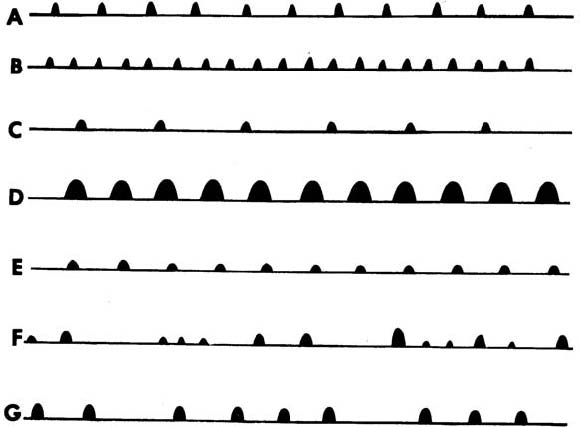When taking a patient’s pulse, you should note the patient’s pulse rate, the strength of the pulse, and the regularity of the pulse.
Most of the pulse characteristics are illustrated in figure 3-1.
a. Pulse Rate.
(1) The normal adult has a pulse rate of about 72 beats each minute. Infants have higher average pulse rates. The normal pulse rate ranges based upon age are given below.
(a) Adults: 60 to 100 beats per minute.
(b) Children: 70 to 120 beats per minute.
(c) Toddlers: 90 to 150 beats per minute.
(d) Newborns: 120 to 160 beats per minute.
(2) Pulse rates that are outside the normal range are classified as tachycardia or bradycardia.
(a) Tachycardia. If the patient’s pulse rate is over 100 beats per minute, the patient is said to have tachycardia. Tachycardia means “swift heart.” Constant tachycardia could be a sign of certain diseases and heart problems. Often, however, tachycardia is only temporary. Temporary tachycardia can be caused by exercise, pain, strong emotion, excessive heat, fever, bleeding, or shock.
(b) Bradycardia. If the patient’s pulse rate is below 50 beats per minute, the patient is said to have bradycardia. Bradycardia means “slow heart.” Bradycardia can be sign of certain diseases and heart problems. Certain medicines, such as Digitalis, can result in bradycardia.
b. Strength.
The strength (force) of the pulse is determined by the amount of blood forced into the artery by the heartbeat. A normal pulse has a normal strength. You will be able to identify a normal strength pulse with practice.
(1) Bounding. If the heart is pumping a large amount of blood with each heartbeat, the pulse will feel very strong. This strong pulse is called “bounding” pulse (as in “by leaps and bounds”). A bounding pulse can be caused by exercise, anxiety, or alcohol consumption.
(2) Weak. If the heart is pumping only a small amount of blood with each heartbeat, the pulse will be harder to detect. This type of pulse is called weak, feeble, or thready. If the pulse is weak, you may have trouble finding (palpating) the pulse at first.
(3) Strong. A strong pulse is stronger than normal pulse, but is less than bounding. Shock and hemorrhage (serious bleeding) can cause a strong pulse.
c. Rhythm.
Rhythm refers to the evenness of the beats. In a regular pulse, the time between beats is the same (constant) and the beats are of the same strength.
(1) Irregular. A pulse is irregular when the rhythm does not have an even pattern. The time between beats may change, or the strength of the beats may change or the pulse may vary in both time between beats and strength.
(2) Intermittent. An intermittent pulse is a special type of irregular pulse. A pulse is intermittent when the strength does not vary greatly, but a beat is skipped (missed) either at regular or irregular intervals. If the missing beats in an intermittent pulse were present, then the pulse rhythm would be normal.
NOTE: Examples of some pulse patterns are illustrated in figure 3-1.

A Regular.
B Tachycardia.
C Bradycardia,
D Bounding.
E Weak (thready).
F Irregular.
G Intermittent (irregular).
